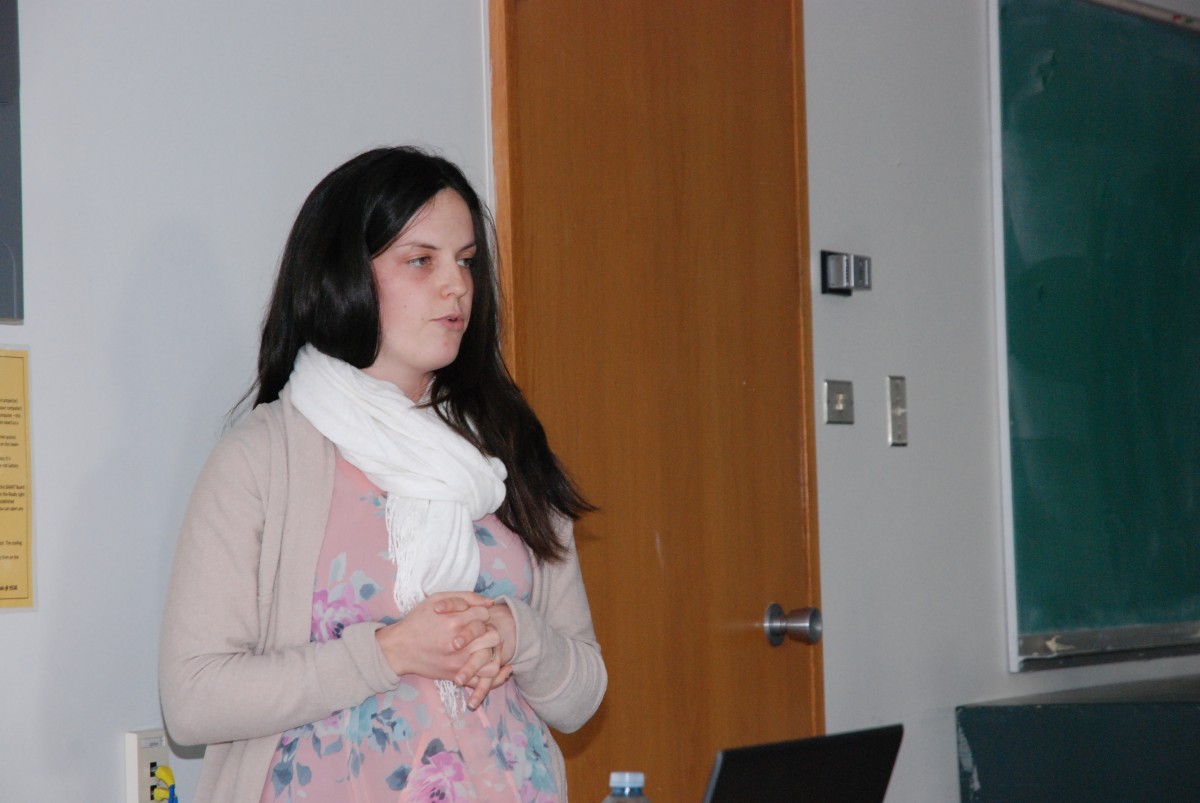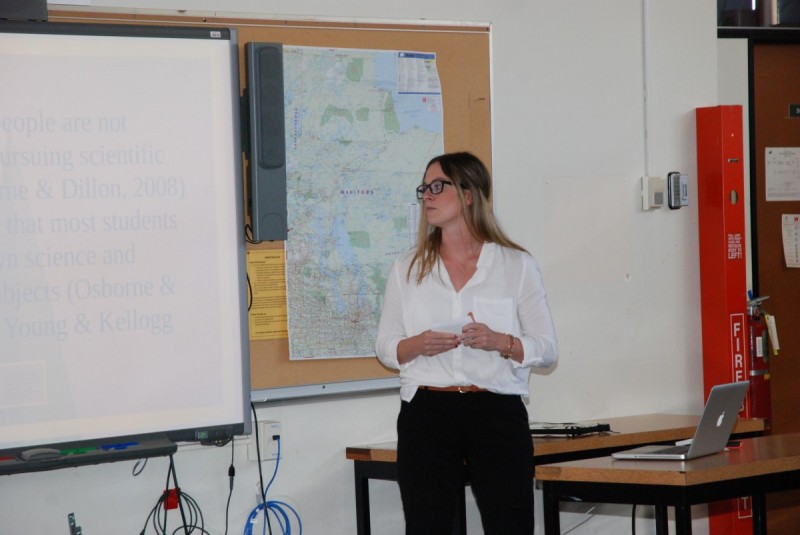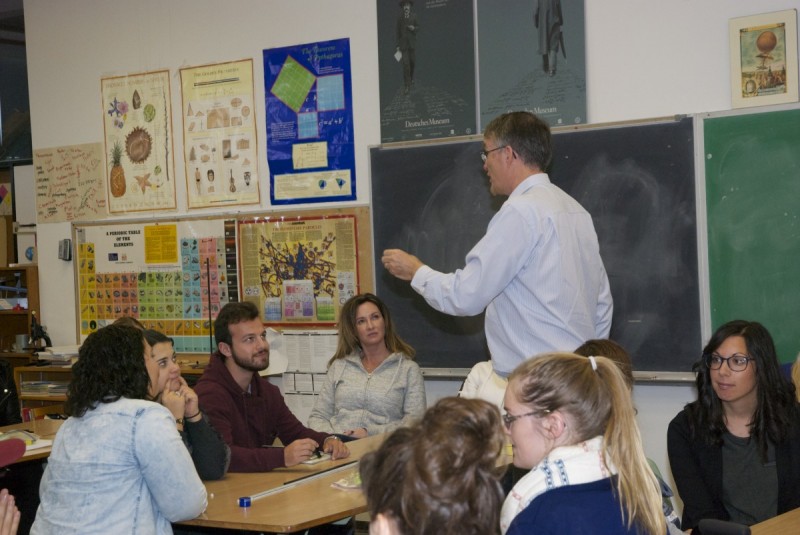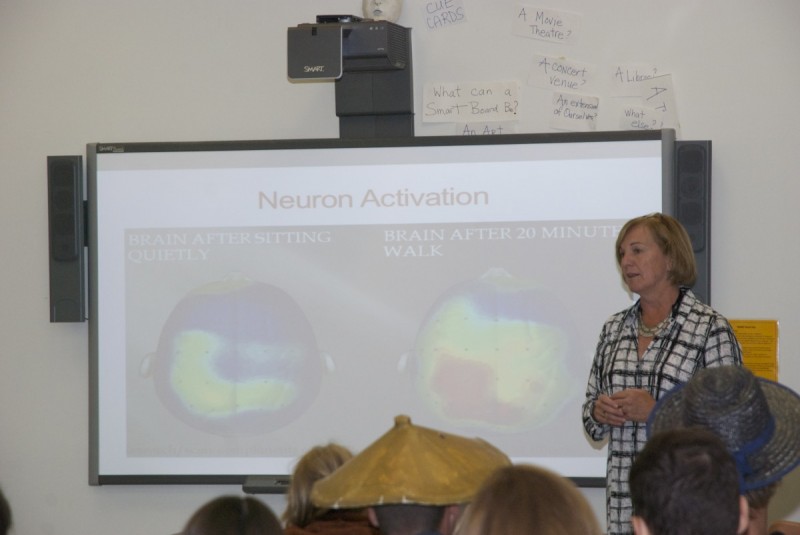
Caitlyn Arnould, an Undergraduate Research Award Winner, worked with professor Melanie Janzen. She presented her research exploring northern practicum experiences across Canada.
Second annual Faculty Research Day attracts more than 400 students
Presentations cover everything from reluctance to teach science to the effects of physical activity in the classroom to teaching about social inequity
The Faculty of Education’s second-annual Faculty Research Day featured 25 presentations by faculty members and student and graduate researchers—and attracted more than 400 B.Ed. students—proving that the event was even more popular this year than during its inaugural year.
The focus-on-research event was conceived of in 2013 by dean David Mandzuk. It was designed not only to inform students and colleagues about research being undertaken in the faculty, but also to encourage teacher candidates to think about the possibilities of research—both at the undergraduate level and beyond.
Mandzuk told students during this year’s opening session that in order to become well-rounded teachers, they needed to develop an appreciation for both theory and practice.
Along with an increased focus on undergraduate research at the University of Manitoba, teacher research is being embraced by school divisions across the province as a form of professional development.
This year’s research day was held Sept. 28 and included sessions on a variety of topics, from teaching from YouTube videos to teaching writing and literacy for social justice to the impact of an afterschool orchestra program on children’s attendance and academic achievement.
Presentations made by URA winners
Along with sessions held by professors and graduate students, this year’s Faculty Research Day featured four presentations by the 2015 Undergraduate Research Award winners. The URA allows undergrads to be mentored by a professor of their choice and develop experience conducting and analyzing research. Four professors—Richard Hechter, Michelle Honeyford, Melanie Janzen and Joanna Black—mentored the students during the spring and summer.
Caitlyn Arnould worked with Janzen exploring northern practicum experiences. They looked at literature on teacher candidates’ experiences in northern communities, presented data on northern practicums across Canada and especially looked at levels of interest in doing such practicums.
Only two universities of 60 they contacted in Canada specifically offer northern practicum.
“This isn’t a large number of universities,” said Arnould. Additionally, they found that northern practicums were not a major area of interest for students. They also found that of the students who did experience northern practicums, many found it “the most valuable part of the B.Ed. experience.”
The next step for Arnould and Janzen is to recruit participants for phenomenological interviews and then analyze the data through a place-based lens, to find out what the experiences were like when people were in practicum.
Kaitlin Downs spent the summer working with Hechter, investigating teachers’ reluctance to teach science in order to find ways to make teachers more comfortable with the subject matter.
Downs also spoke about Hechter being an incredible mentor. “Dr. Hechter’s passion for science is genuinely contagious,” she said. Part of what he was finding was that students aren’t getting opportunities to do much real science in schools. “We thought, why is this taking place?” They came up with two possibilities: One, that students must be caught at a young age to get them, and keep them, interested in science. The other possibility? Teachers were not comfortable teaching.
“We all know educators play a positive or negative role in students’ learning,” said Downs. “Teachers’ attitudes are a big area of research. If teachers have a negative attitude it will give students a less positive attitude [toward science].”
Downs said she spent the summer looking into several factors as to why teachers have difficulty with the subject of science, including that they have limited equipment, time, space or support from other teachers. As well, many felt a lack of confidence in their own knowledge. Downs and Hechter decided to focus on early years teachers because it’s the “time to get people interested.”
They began developing an ongoing professional development program, which will help support teachers become more knowledgeable and comfortable teaching science. The new, one-year program of seven to eight sessions is called Teachers Empowering and Mentoring Peers Toward Engaged Science Teaching. The goal is to create an effective learning community where teachers are actively participating and mentoring each other, and meeting regularly.
The next step is to try to secure a SSHRC grant in spring 2016 to continue with the work, said Downs.
URA winner Shawna McLeod worked with professor Joanna Black and spent time this past summer conducting historical research into two Canadian artists—Arthur Lismer and Anne Savage—focusing on the ways they juggled both their art and teaching careers to gain insight into the contemporary artist/teacher dichotomy. “This research has personal significance, as I am a practicing visual artist who is entering the teaching field,” said McLeod. “It has helped me to gain perspective on my experience, as I begin to understand the complex negotiation it takes to maintain both an artistic practice and a teaching practice at the K-12 level.”
McLeod and Black’s work led to a paper and a presentation at Research Day called Navigating the Artist/Teacher Duality: Past and Present. Dr. Black served as editor and advisor, while the research and analysis was by McLeod. McLeod also plans to present her findings to the ‘Teaching Art in the Senior Years’ class in the winter term.
URA winner Andrew Wu worked on the Manitoba Writing Project with professor Michelle Honeyford. Honeyford’s writing project is focused on teaching writing and literacy both as, and for, social justice. Wu looked at the works of several K-12 teachers who are changing the way their classrooms and schools are set up in terms of justice and human rights.
Presentations by faculty and graduate students
Other presentations were conducted by faculty members, who spoke about some of their current projects. They included Hechter’s enthusiastic presentation on his research into the aurora borealis which took him from Churchill, Man., to Tel Aviv and underlined for him how science and the night sky can underline interconnectedness of people –no matter what their cultural, geographic or political background.
Professor Ralph Mason talked about the quest for foundational experiences for mathematics in order to help children achieve success in that subject area, while professor Gregory Bryan presented his research on award-winning picture book author and illustrator Paul Goble. Bryan has just completed a biography of Goble’s life and included examples of his illustrations and some of the influences on his artwork.
PhD student Chelsea Jallhoh spoke about the social determinants of health in the confines of teaching, and explored a framework for teaching and learning about societal inequity and privilege for both students and teachers. Part of the conversation was examining what privilege is and who in society is privileged—ie. does being born in Canada or having a certain sexual orientation make you privileged?
Jalloh said that certain factors can make teaching about social inequities uncomfortable, citing Megan Boler’s “Pedagogy of Discomfort” (1999). She recommended that teacher candidates look at Boler’s work and reflect how they can create a classroom of empathy. “It drives change. As educators you have an enormous amount of power to drive change.”
She noted that what Boler suggests is educators go beyond feeling guilty about the inequities of some people and instead encourage and motivate students to take up issues in order to create change.
Recent M.Ed. graduate Kathy Isaac, meanwhile, discussed her thesis topic, which focused on whether brief physical activity in the morning helped student engagement in the classroom. Isaac, who was a phys. Ed. teacher for 29 years, became interested in studies showing that much more of the brain is lit up after physical activity than during rest periods. Isaac conducted a study last year as part of her thesis in which she looked at whether physical activity in the morning in schools resulted in increased student engagement in classroom. Her results showed that there was a positive change in student engagement as charted by teachers and educational assistants.
“The results suggest that the difference is beyond chance. Specifically, the results suggests that when students engage in 15 minutes of physical activity the positive effects will be felt 45 minutes later.”
Anecdotally, there were other benefits. Isaac said teachers told her that students enjoyed the socialization of being able to walk and talk with their classmates in the morning.
“It came to kind of have a community feel.”
Research at the University of Manitoba is partially supported by funding from the Government of Canada Research Support Fund.









